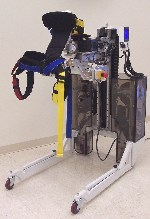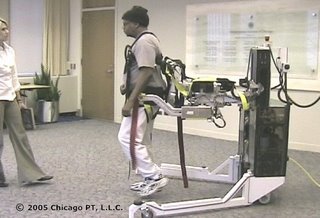KineAssist - A physical therapist's tool
For most stroke patients, physical therapy (PT) plays a very important part in the rehabilitation process. A physical therapist uses training, exercises and physical manipulation of the patient's body to restore a sense of balance, coordination and movement, enabling the patient to relearn simple motor activities such as walking, sitting, standing.
 In this process, the utmost priority of the therapist is safety of the patient. However, this concern for safety can sometimes get into the way of progress, particularly in the case of reteaching the patient to walk. This may sound counter-intuitive: safety hinders the healing process? In actual fact, the process of walking involves throwing oneself off balance on one leg and then catching oneself again on the other leg. And it is found that making mistakes in this process and learning to adapt to it enables the stroke patient's brain to rewire itself around the injury. However, such mistakes can be very dangerous to the patient as they may injury themselves further when they fall.
In this process, the utmost priority of the therapist is safety of the patient. However, this concern for safety can sometimes get into the way of progress, particularly in the case of reteaching the patient to walk. This may sound counter-intuitive: safety hinders the healing process? In actual fact, the process of walking involves throwing oneself off balance on one leg and then catching oneself again on the other leg. And it is found that making mistakes in this process and learning to adapt to it enables the stroke patient's brain to rewire itself around the injury. However, such mistakes can be very dangerous to the patient as they may injury themselves further when they fall.  As such, a robot called KineAssist designed by Chicago PT aims to allows stroke patients to make mistakes safely, resolving the physical therapist's conundrum. The robotic technology is able to sense or anticipate the intended movement of the patient, and follow accordingly. This robot was designed not to interfere, only catching the patient if he lost balance, but to provide enough assistance so as to enable the PT to perform other tasks. The arms and harness on the robot enables different degrees of support to be given to the patient depending on their ability to walk. In the initial phrase of relearning to walk, the robot might support all of the patient's weight and move slowly forward. As the patient gets stronger, the physical therapist can program the robot to let the patient bear more weight and the perform more challenging exercises such as moving in kicking a ball. In even later stages of the therapy, the robot can nudge patients off balance to help them learn to recover their balance.
As such, a robot called KineAssist designed by Chicago PT aims to allows stroke patients to make mistakes safely, resolving the physical therapist's conundrum. The robotic technology is able to sense or anticipate the intended movement of the patient, and follow accordingly. This robot was designed not to interfere, only catching the patient if he lost balance, but to provide enough assistance so as to enable the PT to perform other tasks. The arms and harness on the robot enables different degrees of support to be given to the patient depending on their ability to walk. In the initial phrase of relearning to walk, the robot might support all of the patient's weight and move slowly forward. As the patient gets stronger, the physical therapist can program the robot to let the patient bear more weight and the perform more challenging exercises such as moving in kicking a ball. In even later stages of the therapy, the robot can nudge patients off balance to help them learn to recover their balance.All these are performed under a safety net as the robot is able to sense when the patient is starting to drop and is able to stop a fall. "The need to hold on to patients to prevent them from falling interferes with PTs' abilities to use their hands more creatively and intelligently to help a person learn to move better," explained Dr. Brown. "We've created a way for clinicians to perform challenging interventions for patients with balance and walking disorders. Clinicians can challenge their patients while providing safety."
The pictures show a person being caught by the KineAssist and his recovery from the fall.
References:
http://www.chicagopt.com/
http://www.technologyreview.com/articles/05/09/issue/forward_rehab.asp

